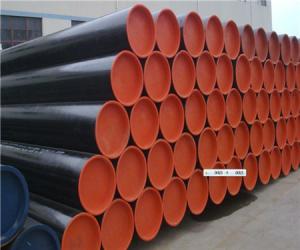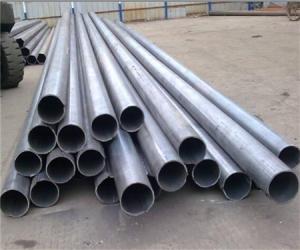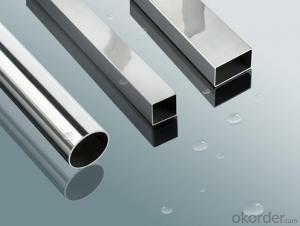Seamless Stainless Steel Pipe S31803 China Factory
- Loading Port:
- China Main Port
- Payment Terms:
- TT or LC
- Min Order Qty:
- 30 m.t.
- Supply Capability:
- 12000 m.t./month
OKorder Service Pledge
OKorder Financial Service
You Might Also Like
1、Structure of Seamless Pipe ASTM A106/53:
1.duplex S31803 stainless steel seamless pipe
2.OD:3-580MM WT:1-30MM
3.ASTM A240/789/790
4.chemical industry pipe
5.Zhejiang
2、Main Features of the Seamless Pipe ASTM A106/53:
• High manufacturing accuracy
• High strength
• Small inertia resistance
• Strong heat dissipation ability
• Good visual effect
• Reasonable price
3、Seamless Pipe ASTM A106/53 Specification:
Standard | GB, DIN, ASTM ASTM A106-2006, ASTM A53-2007 |
Grade | 10#-45#, 16Mn 10#, 20#, 45#, 16Mn |
Thickness | 8 - 33 mm |
Section Shape | Round |
Outer Diameter | 133 - 219 mm |
Place of Origin | Shandong, China (Mainland) |
Secondary Or Not | Non-secondary |
Application | Hydraulic Pipe |
Technique | Cold Drawn |
Certification | API |
Surface Treatment | factory state or painted black |
Special Pipe | API Pipe |
Alloy Or Not | Non-alloy |
Length | 5-12M |
Outer Diameter | 21.3-610mm |
Grade | 20#, 45#, Q345, API J55, API K55, API L80, API N80, API P110, A53B |
Standard | ASME, ASTM |
4、Packaging & Delivery
Packaging Details: | seaworthy package,bundles wrapped with strong steel strip |
Delivery Detail: | 15-30days after received 30%TT |
5、FAQ of Seamless Pipe ASTM A106/53:
①How is the quality of your products?
Our products are manufactured strictly according to national and internaional standard, and we take a test
on every pipe before delivered out. If you want see our quality certifications and all kinds of testing report, please just ask us for it.
Guaranteed: If products’ quality don’t accord to discription as we give or the promise before you place order, we promise 100% refund.
②How about price?
Yes, we are factory and be able to give you lowest price below market one, and we have a policy that “ for saving time and absolutely honest business attitude, we quote as lowest as possible for any customer, and discount can be given according to quantity”,if you like bargain and factory price is not low enough as you think, just don’t waste your time.Please trust the quotation we would give you, it is professional one.
③Why should you chose us?
Chose happens because of quality, then price, We can give you both.Additionally, we can also offer professional products inquiry, products knowledge train(for agents), smooth goods delivery, exellent customer solution proposals.Our service formula: good quality+good price+good service=customer’s trust
SGS test is available, customer inspection before shipping is welcome, third party inspection is no problem.
6、Seamless Pipe ASTM A106/53 Images:
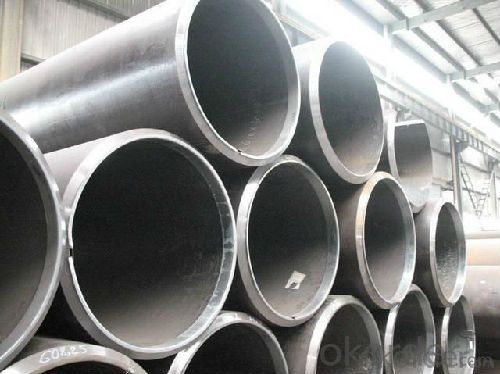
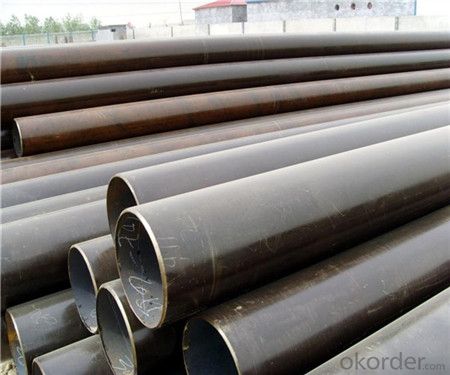
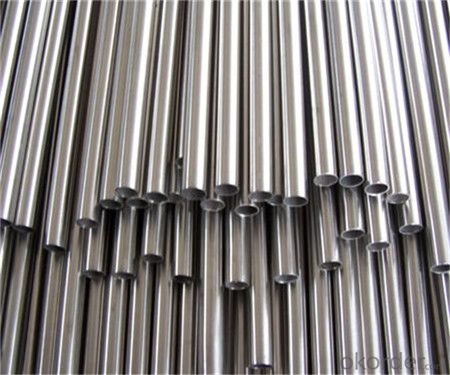
- Q:Are stainless steel pipes suitable for pharmaceutical applications?
- Stainless steel pipes are a great choice for pharmaceutical applications. They are made from a highly durable and corrosion-resistant material that is extensively used in the pharmaceutical industry for a range of purposes, including transporting and storing pharmaceutical products, constructing equipment, and process piping. One of the primary benefits of stainless steel pipes is their ability to resist corrosion, which is crucial in pharmaceutical settings where preventing contamination is of utmost importance. Stainless steel can withstand a wide range of chemicals and aggressive substances, ensuring that the quality and integrity of pharmaceutical products remain intact. Moreover, stainless steel pipes offer excellent hygienic properties. They are easy to clean and sterilize, making them ideal for pharmaceutical applications that require strict cleanliness standards. The smooth and non-porous surfaces of stainless steel pipes have minimal bacterial adhesion, making it simpler to maintain a sterile environment. In addition to their corrosion resistance and hygienic properties, stainless steel pipes are also known for their high strength and durability. They can endure high temperatures and pressures, making them suitable for various pharmaceutical processes. Stainless steel pipes also possess exceptional mechanical properties, such as impact resistance and fatigue strength, ensuring long-lasting performance and minimizing the risk of failures in pharmaceutical applications. Overall, stainless steel pipes are widely utilized in the pharmaceutical industry due to their corrosion resistance, hygienic properties, and durability. They provide a dependable and secure solution for transporting and storing pharmaceutical products while maintaining a clean and sterile environment.
- Q:What is the difference between 17-7 and 15-7 stainless steel pipes?
- The composition and properties distinguish 17-7 stainless steel pipes from 15-7 stainless steel pipes. 17-7 stainless steel is characterized as a precipitation-hardening stainless steel with approximately 17% chromium and 7% nickel. It is also alloyed with aluminum, enabling it to undergo heat treatment for achieving high strength and hardness. This stainless steel grade is renowned for its exceptional corrosion resistance, good formability, and high strength. It finds application in industries that demand high strength and corrosion resistance, such as aerospace components, springs, and chemical processing equipment. Contrarily, 15-7 stainless steel is classified as a semi-austenitic precipitation-hardening stainless steel comprising about 15% chromium and 7% nickel. Additionally, it is enriched with 2% molybdenum, which enhances its corrosion resistance. This stainless steel grade offers favorable mechanical properties, high strength, and excellent corrosion resistance. It is commonly utilized in fields requiring high strength, good formability, and resistance to stress corrosion cracking, such as springs, washers, and medical devices. To summarize, although both 17-7 and 15-7 stainless steel pipes exhibit excellent corrosion resistance and high strength, their composition and specific properties distinguish them. 17-7 stainless steel contains aluminum to enhance its heat treatability, while 15-7 stainless steel includes molybdenum for improved corrosion resistance. The selection between these two grades depends on the specific application requirements, encompassing strength, formability, and resistance to corrosion or stress corrosion cracking.
- Q:Are stainless steel pipes suitable for underground sewage systems?
- Certainly, underground sewage systems benefit greatly from the use of stainless steel pipes. Renowned for their resilience, robustness, and resistance to corrosion, stainless steel pipes prove to be an optimal selection for subterranean applications. With an extended lifespan, they can endure the demanding circumstances commonly encountered in sewage systems, such as exposure to moisture, chemicals, and fluctuating temperatures. Furthermore, the smooth interior surface of stainless steel pipes serves to prevent the accumulation of debris or waste, effectively decreasing the likelihood of clogs or obstructions. In summary, stainless steel pipes present a dependable and enduring solution for underground sewage systems.
- Q:Can stainless steel pipes be insulated?
- Yes, stainless steel pipes can be insulated. Insulation is commonly used on pipes to prevent heat loss or gain, and stainless steel pipes are no exception. Insulating stainless steel pipes can provide several benefits, such as reducing energy costs, preventing condensation, and maintaining the temperature of the fluid inside the pipe. Various types of insulation materials, such as fiberglass, foam, or mineral wool, can be used to insulate stainless steel pipes, depending on the specific requirements of the application. Insulating stainless steel pipes is a common practice in industries such as oil and gas, chemical processing, and HVAC systems.
- Q:Can stainless steel pipes be used for solar energy systems?
- Yes, stainless steel pipes can be used for solar energy systems. Stainless steel is a versatile and durable material that can withstand the harsh conditions of solar energy systems. It is resistant to corrosion, which is crucial for the longevity of the pipes in outdoor and exposed environments. Stainless steel pipes also have excellent heat resistance properties, making them suitable for transporting hot fluids within solar energy systems. Additionally, stainless steel has a high strength-to-weight ratio, making it ideal for supporting the weight of solar panels or other components in the system. Overall, stainless steel pipes are a reliable and efficient choice for solar energy systems.
- Q:Are stainless steel pipes resistant to acidic solutions?
- Generally, stainless steel pipes exhibit resistance to acidic solutions due to the high chromium content. This chromium forms a protective layer that shields the metal from corrosion, preventing any harm caused by the acid. Nevertheless, the level of resistance can differ among various grades of stainless steel. Certain grades offer greater acid resistance compared to others. To determine the most appropriate grade for a specific application involving acidic solutions, consulting the manufacturer or a corrosion specialist is essential.
- Q:How do you calculate the flow rate in stainless steel pipes?
- In order to determine the flow rate in stainless steel pipes, one can utilize the principles of fluid dynamics along with the properties of the fluid being conveyed through the pipe. There are several factors which must be taken into account: 1. The first step is to ascertain the diameter of the pipe. This parameter significantly impacts the flow rate as a larger diameter allows for a greater volume of fluid to pass through. 2. The second step involves determining the viscosity of the fluid. Viscosity refers to the fluid's resistance to flow. Fluids with high viscosity flow at a slower rate, whereas those with low viscosity flow more rapidly. 3. The next consideration is the calculation of the pressure drop across the pipe. This factor plays a crucial role in establishing the flow rate, and it can be computed by measuring the pressure at different points along the pipe. 4. The Reynolds number is then employed. This dimensionless value combines the fluid's velocity, density, viscosity, and pipe diameter. It aids in determining whether the flow is laminar (smooth) or turbulent (chaotic). Different equations exist to calculate the Reynolds number based on the flow regime. 5. The final step involves the application of the appropriate flow equation. Depending on the flow regime, various equations can be utilized to calculate the flow rate. For laminar flow, the Hagen-Poiseuille equation is applicable, while the Darcy-Weisbach equation or the Manning equation can be employed for turbulent flow. By considering these factors and employing the appropriate equations, the flow rate in stainless steel pipes can be determined. It is important to note that these calculations provide an estimate and may not yield exact results due to factors such as pipe roughness, fittings, and other obstructions within the pipe. Therefore, it is advisable to consult a fluid dynamics expert or employ specialized software for accurate calculations.
- Q:Can stainless steel pipes be surface treated?
- Yes, stainless steel pipes can be surface treated through various methods such as pickling, passivation, electropolishing, or coating to enhance their appearance, corrosion resistance, and durability.
- Q:Stainless steel pipe chamfering how to process?
- If the amount of larger or longer steel pipe, you can buy a dedicated handheld steel pipe chamfering tool, called "steel chamfering machine"". This is much more efficient than using a lathe
- Q:What is the difference between 310 and 316 stainless steel pipes?
- The main difference between 310 and 316 stainless steel pipes lies in their chemical composition and intended uses. 310 stainless steel is a high-temperature resistant alloy that contains a higher amount of chromium and nickel compared to 316 stainless steel. This composition makes it highly resistant to oxidation and corrosion in high-temperature environments, making it suitable for applications such as furnace parts, heat exchangers, and other high-temperature industrial processes. On the other hand, 316 stainless steel is a more versatile and widely used alloy due to its excellent corrosion resistance properties. It contains a higher amount of molybdenum, which enhances its resistance to pitting and crevice corrosion, especially in chloride environments. This makes 316 stainless steel pipes suitable for various applications such as marine environments, chemical processing, and food processing industries. In summary, while both 310 and 316 stainless steel pipes offer corrosion resistance, 310 stainless steel is specifically designed for high-temperature applications, while 316 stainless steel is more commonly used for general corrosion resistance in various industries.
1. Manufacturer Overview |
|
|---|---|
| Location | |
| Year Established | |
| Annual Output Value | |
| Main Markets | |
| Company Certifications | |
2. Manufacturer Certificates |
|
|---|---|
| a) Certification Name | |
| Range | |
| Reference | |
| Validity Period | |
3. Manufacturer Capability |
|
|---|---|
| a)Trade Capacity | |
| Nearest Port | |
| Export Percentage | |
| No.of Employees in Trade Department | |
| Language Spoken: | |
| b)Factory Information | |
| Factory Size: | |
| No. of Production Lines | |
| Contract Manufacturing | |
| Product Price Range | |
Send your message to us
Seamless Stainless Steel Pipe S31803 China Factory
- Loading Port:
- China Main Port
- Payment Terms:
- TT or LC
- Min Order Qty:
- 30 m.t.
- Supply Capability:
- 12000 m.t./month
OKorder Service Pledge
OKorder Financial Service
Similar products
New products
Hot products
Hot Searches
Related keywords

